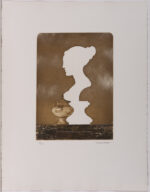Subirachs, Josep Maria
"Considered one of the great contemporary sculptors, he has consciously created a language of his own, structured and solid as a universal language.
BIOGRAPHY OF JOSEP MARIA SUBIRACHS (1927-2014)
Subirachs was born in Barcelona on March 11, 1927.
Sculptor, draftsman and engraver, he worked as an apprentice in the workshop of E. Monjo (1942-1947) and was a free student at the "Escuela de Bellas Artes" in Barcelona (1945). However, his true master was Enric Casanovas (1947-1948), from whom he inherited a Mediterranean style inspired by Maillol. At the age of twenty-one, Subirachs held his first individual exhibition at the Casa del Libro in Barcelona. His stay in Paris in 1951 and his subsequent residence in Belgium, from 1954 to 1956, contributed to his professional training and plural knowledge of the plastic arts of the second half of the twentieth century.
In the search for his own personality, the Mediterranean formation gave rise to an expressionism that the artist showed in the first Salones de Octubre in Barcelona (1949-1957) with his work ""Europa"", in which Cuixart, Guinovart, Ponç, Ràfols Casamada, Tàpies and Tharrats, among others, also participated. Subirachs' work quickly entered a process of schematization and deformation that would lead to abstraction. From this period are ""Forma 212″" and ""Evocació Marinera"", the first two abstract sculptures placed outdoors in the city of Barcelona. In these works he already deepens his peculiar treatment of textures, which is one of his favorite resources to create contrasts and expressiveness. In 1959, Subirachs was commissioned to sculpt the façade and doors of the Sanctuary of the Virgen del Camino, in Lleida, a work in which he introduced a figurative parenthesis in his creative line. These bronze sculptures, slender and schematic, already announced his later evolution towards a neo-figurativism in which he mixed figure and abstraction in an absolutely personal way. In this phase, Subirachs uses the concave-convex dialectic in works where the void acquires its own space in contrast with the mass. The monument to Narcís Monturiol (1963) in Barcelona, the first sculpture located in a public place conceived in the style of the "new figuration", stands out from this period.
His creations have gained considerable public recognition. He received important commissions such as the façade of the Barcelona City Hall (1969), the monument to Mexico in Mexico City (1968), the monument to the Olympics in Lausanne (1983), the sculptural covering of the Passion façade of the Sagrada Familia church in Barcelona (from 1986 to the present), the Union of East and West in Seoul (1989) and the monument to Francesc Macià in Plaza Catalunya in Barcelona (1991).
He has used all kinds of materials: terracotta, bronze, wood, iron, stone, fiber cement, concrete, marble, copper, glass, aluminum, ivory and steel. As an engraver, he has worked with etching, lithography, silkscreen, linoleum and drypoint. Subirachs' work is characterized by a high mastery of technique and great formal scrupulousness. He is fascinated by mythology rooted in the Greco-Latin, Jewish or Christian tradition, and in this sense, we often find in his work classical elements: caryatids, sphinxes, capitals, niches, moldings, obelisks, pyramids and balustrades. On a conceptual level, he is inclined towards irony, visual paradox, eroticism and contrasts. He has consciously created his own language, structured and solid as a universal language. Undoubtedly, Subirachs is one of the great creators of our time."
Showing the only result

